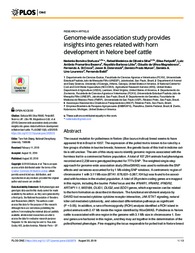Genome-wide association study provides insights into genes related with horn development in Nelore beef cattle.
Genome-wide association study provides insights into genes related with horn development in Nelore beef cattle.
Summary: Abstract The causal mutation for polledness in Nelore (Bos taurus indicus) breed seems to have appeared first in Brazil in 1957. The expression of the polled trait is known to be ruled by a few groups of alleles in taurine breeds; however, the genetic basis of this trait in indicine cattle is still unclear. The aim of this study was to identify genomic regions associated with the hornless trait in a commercial Nelore population. A total of 107,294 animals had phenotypes recorded and 2,238 were genotyped/imputed for 777k SNP. The weighted single-step approach for genome-wide association study (WssGWAS) was used to estimate the SNP effects and variances accounted for by 1 Mb sliding SNP windows. A centromeric region of chromosome 1 with 3.11 Mb size (BTA1: 878,631?3,987,104 bp) was found to be associated with hornless in the studied population. A total of 28 protein-coding genes are mapped in this region, including the taurine Polled locus and the IFNAR1, IFNAR2, IFNGR2, KRTAP11-1, MIS18A, OLIG1, OLIG2, and SOD1 genes, which expression can be related to the horn formation as described in literature. The functional enrichment analysis by DAVID tool revealed cytokine-cytokine receptor interaction, JAK-STAT signaling, natural killer cell mediated cytotoxicity, and osteoclast differentiation pathways as significant (P < 0.05). In addition, a runs of homozygosity (ROH) analysis identified a ROH island in polled animals with 2.47 Mb inside the region identified by WssGWAS. Polledness in Nelore cattle is associated with one region in the genome with 3.1 Mb size in chromosome 1. Several genes are harbored in this region, and they may act together in the determination of the polled/horned phenotype. Fine mapping the locus responsible for polled trait in Nelore breed and the identification of the molecular mechanisms regulating the horn growth deserve further investigation.
Publication year: 2018
Types of publication: Journal article
Unit: Embrapa Cerrados
Keywords: Bos Indicus, Gado Nelore, Mutação
Observation
Some of Embrapa's publications are published as ePub files. To read them, use or download one of the following free software options to your computer or mobile device. Android: Google Play Books; IOS: iBooks; Windows and Linux: Calibre.
Access other publications
Access the Agricultural Research Database (BDPA) to consult Embrapa's full library collection and records.
Visit Embrapa Bookstore to purchase books and other publications sold by Embrapa.

